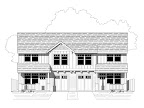Last week we looked at how to calculate your heat load based on the envelope of your home. This week we'll take a look at air infiltration and the effect it can have on your home. The caveat should be given that the tighter you make your home, the more you should be concerned about vapor barriers, retarders, and other management. Indoor air quality also becomes a concern. We won't address these issues in this post.
Air infiltration is not something that can be assumed or calculated. Just as a nail can't be driven by estimation, it needs a tool. The most common tool used is a blower door. This is a device that attaches into your front door frame and accepts a large industrial fan. After closing all other doors and windows, the fan is turned on (generally pointing out) until it is removing 50 cubic feet per minute (CFM) from your home. Some places in the world aim for 25 CFM. For a visual, imagine 4 regulation basketballs. This is 1 cubic foot. So turning the blower door on to 50 CFM means that you are throwing 200 basketballs out your front door every minute (or more than 3 every second!)
Why in the world would you do this? A couple of reasons. First, this is a great opportunity to walk around your house with a smoke stick and see where air is leaking in. These are places that need to be plugged. Get your caulk, foam, whatever and fill it up.
Second, since there is diagnostic equipment hooked to the blower door, a technician can determine how much air will blow through your home on a windy day. The result is a standardized answer that can be used for comparison. Generally it is in the range of 0-20 air changes per hour (ACH). This means that with the blower door running, the volume of air in your home could be changed out 20 times an hour. Every 3 minutes you're getting new air. This air is coming from outside, the attic, the crawlspace, and the attached garage.
Most newer homes fall around 6 ACH50. Older homes will be much higher. It takes some determination to lower a new home from 6 ACH50. No one accidentally builds a tight home. With some simple effort we have seen homes approach 4 ACH50. A bit more effort and change in building methods results in 2 ACH50 which is very good. The lowest we've ever seen is 0.22 ACH50. This was a home built to PassivHaus standards.
So why does this matter for energy calculations? Warm air can be blown out of your home and replaced with cool winter air through leaks. We need to calculate for this for the furnace to be able to keep up. Otherwise your home will get cooler and cooler until it equalizes with the outdoors. This could occur with a 3000sf leaky home and a 40kBTU furnace. Bad news.
Less talking, more computing. This is one single formula that has a lot of lead up. There are four numbers in the formula. The first is our friend ΔT. The second is the result of your blower door test in ACH50. We need natural ACH so divide by 20. The third is the volume of your heated area. The fourth is the convective heat transfer co-efficient (HC). This number has a general range around 0.018 to 0.022:
ΔT x ACHnat x Volume x HC = BTU/hr
Example: A 1500sf house has a blower door result of 3.5ACH50. Assume HC to be 0.022 (Marine Cold). What is the heat loss through infiltration?
Answer: ΔT from last week is still 45°F. ACHnat = ACH50/20 which is 3.5/20 = 0.175. Volume is approximately 1500sf x 9' (ceilings) = 13500cf. HC is stated. So the formula is 45 x 0.175 x 13500 x 0.022 = 2339 BTU/hr. Note that we gave a tightness that is half of typical. Were it 7 ACH50 this load would double! Don't think air tightness matters? It's the biggest factor in heat load.
Add this to your envelope load and come back next week for part three, Interior Loads!
Tuesday, October 18, 2011
Subscribe to:
Post Comments (Atom)





No comments:
Post a Comment